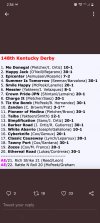Betting horses is not much different than other sports betting....you can put as much or as little time into research as you want. You can bet hunches, you can run mostly favorites or look for those live dogs. Instead of parlays we have Pick 3s, Pick 4s, etc., where you string multiple bets together. Instead of same game parlays we have exactas, trifectas and superfectas where you're picking the top 2, 3 or 4 finishers.
If you're talking about reviewing past performances, first you need to pick a type of past performance sheet. The four most popular are Daily Racing Form (by far the most popular), Timeform, Brisnet and Equibase. They all offer the same basic info (Horse, Jockey, Trainer, Horse's record, speed ratings (all 3 have different numbers), running line for each of the last 10 races, etc.) and then a few things special to their sheets.
I prefer Brisnet for a few reasons:
1) you can find them online for free. Go to Cindy Pierson Dulay's website, she has past performances sorted by trainers, some sires, and some larger stables. Sometimes you need to click, go back, click again to get to the info, depending on your operating system. I guess they do that to discourage the lazy.
Finding specific races is not as easy as it used to be. In the past WhoBet used to curate all the public pps and sort them by track. Now I go to Equibase, go to their entries page and look at trainers and sires to figure out where to find the races on Cindy's list. Luckily many of the big trainers (Chad, Todd, Cox, Baffert, O'Neil, Mott, Rice, Romans, Ward) allow direct access for the races they've entered. The big track races are usually easy enough to find.
2) they have a library at
http://www.brisnet.com/cgi-bin/static.cgi?page=library where they tell you everything they have on their pps and what it means from a racing standpoint. It is an invaluable resource.
3) I really like their measures on running styles (great for visualizing how a race will unfold), race pace (great for 2 turn races) and class (great for turf races) as something to consider in addition to speed numbers.
As far as how to pick horses, there have been dozens of books written on the subject. Very briefly, what you're trying to do is two things: 1) measuring the potential of each horse and 2) figuring out how likely it is that the best half of those horses can run to their potential in that race.
There are countless tips and rules of thumb to consider. Among my favorites:
1) Pace makes the race - to me that means if their are too many early speed horses in the race, the closers come into play. Otherwise its highly likely the winner will spend the whole race within 3 or so lengths of the lead.
2) Turf races are about class and closing - turf races often run slow early with everyone waiting to make moves on the far turn and stretch. Horses with proven class and late running ability tend to do well.
3) Be wary of favorites trying to do something for the first time - new equipment, new jockey, stretching out, switching surfaces, etc. all question marks that can make the favorite (who only wins about a third of the time anyway) vulnerable
4) Claiming races are as much about angles as they are potential - find horses in the top half of the field that have changes that could raise their effort (new trainer, cutback in distance, sharp work, blinkers on or off, new to lasix, etc.)
5) When nothing looks special, go with the unknown - especially true with maidens and maiden claimers, shippers, surface switchers. If what you see on paper doesn't appeal, then the unknown horses are worth an extra look
I like to budget 15 to 30 minutes on race analysis. Some don't like to spend that kind of time. To each their own.

